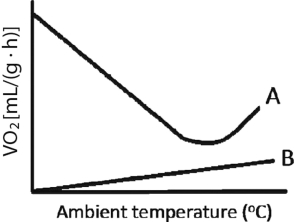Multiple Choice
Researchers measure animals' oxygen consumption (VO₂) as a way to quantify metabolic rate. A researcher measured the VO₂ for two animals, A and B, as function of ambient temperature and collected the data shown in Figure 32.2 below. One of the animals was an ectotherm and one was an endotherm. Which animal was the endotherm and why? 
A) Animal A is the endotherm because at colder temperatures endotherms need to warm themselves through their own metabolic activity, which is supported by the data.
B) Animal A is the endotherm because endotherms do not need to regulate their own body temperature by changing metabolic activity, which is supported by the data.
C) Animal B is the endotherm because at colder temperatures endotherms need to warm themselves through their own metabolic activity, which is supported by the data.
D) Animal B is the endotherm because endotherms do not need to regulate their own body temperature by changing metabolic activity, which is supported by the data.
Correct Answer:

Verified
Correct Answer:
Verified
Q2: Hormones that promote homeostasis<br>A) usually operate as
Q4: The body's automatic tendency to maintain a
Q7: Which of the following has (have)both endocrine
Q7: The interrelationships between the endocrine and the
Q8: Muscles are joined to bones by<br>A) ligaments.<br>B)
Q9: After drinking alcoholic beverages, increased urine excretion
Q11: ADH and RAAS work together in maintaining
Q20: Food moves along the digestive tract as
Q29: In a typical nerve cell, the nucleus
Q31: Positive feedback differs from negative feedback in